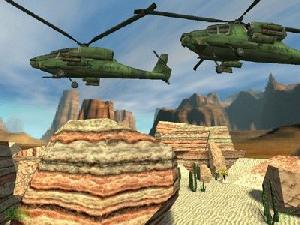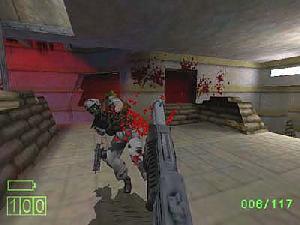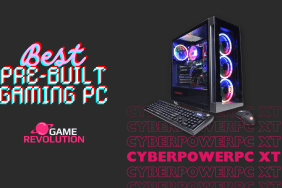Half-Life, Not Half Bad.
There have been obvious repetitions that have somehow worked their way permanently
into the first person genre. Repetitive gameplay and a weak story seem to hinder
almost every new game making their way into this supersaturated market. Now, here
comes Half-Life, a game as hyped as Unreal
or Quake II,
but a few questions still remain. Does Half-Life stand up to its hype?
Is there a need for it in this overcrowded and repetitive genre? Unquestionably,
the answer to both questions is yes.
If you haven’t even caught a glimpse
of the hype that surrounded the release of Half-Life, then the rest of
the gaming world and I pity you. One of the most stressed aspects of the game
is its immersive single player experience. The game has been featured on so
many web-sites and in so many magazines it would make your head spin, so bear
with me for a moment while I repeat what you might have already heard . . .
You play as Gordon Freeman, a scientist at the Black Mesa Research Facility, conducting dangerous and top secret genetic experiments. Without giving away too much of the story let me just say that, after a freak accident (or was it an accident…), you find yourself battling amongst unearthly creatures in an effort to free yourself, save yourself from government troops, and to eventually save the world. The story is revealed through dialogues with other scientists, overheard conversations, and other various clues discovered throughout the game.
Unlike other first person shooters (FPS), the story is not abandoned in the
middle of the game for bigger weapons and constant mayhem (a la Unreal).
Ambient music does an awesome job at setting the tone, and a barrage of sound
effects seriously compliments the single player experience. From start to finish,
with the exception of Thief,
Half-Life provides the best single player experience on the first person
market.
While Half-Life‘s gameplay is unmistakably similar to the rest of the
first person genre, there are many subtle differences that give it a nice edge
over others. Half-Life tries to better explain many things that most
other shooters take for granted. For example, Freeman (you) is wearing a battle-suit,
which explains how armor can be added. Weapons and ammo are not placed at random
points throughout the map; players must discover hidden weapon caches and grab
ammo off of enemies. Rarely will you ever see some ammo or armor just lying
in the middle of a hallway. Also, while there are some health packages around,
most health and armor must be obtained from vending machines on walls throughout
the game. Lastly, the entire game is continuous, and the only breaks are the
brief loading times.
 Now, on to one of the most talked-about
Now, on to one of the most talked-about
aspects of the FPS genre: the game’s engine. Just how does Half-Life
graphically compare to other existing engines, namely Lithtech (Shogo,
Blood 2)
and Unreal? Valve combined the Quake and Quake II engines,
along with some of their own code, to create an engine that feels and runs like
Quake II, but with many graphical advantages. Both texture quality and
variation are much better, which result in a better variety of settings. From
the enclosed tunnels of the underground Black Mesa Research Facility, to the
open canyons of surface, Valve did a pretty good job breaking away from the
usual dark, tunneled dungeon feel that most FPS fans are tired of. While Half-Life
does have its fair share of tunneled levels, there are enough other levels that
the variation is commendable.
There are a number of lighting and firing effects throughout the game, few
of which can be compared to those of Unreal. However, all of them are
a huge improvement over Quake and Quake licensed games. Half-Life‘s
hybrid engine is a small step ahead of Monolith’s LithTech, implicit in the
more detailed polygonal objects. In the end, Half-Life cannot visually
compete with the Unreal engine, but Valve made excellent use of their
Quake license.
The big hooplah over Half-Life is due to its amazing AI. Friendly soldiers
and scientists help you whenever they can, while enemies will plot strategies
to kill you more efficiently. Unlike Quake, you can’t just hide in the
shadows and pluck off enemies without them reacting. Instead, they’ll attempt
to outflank you and drive you from your hidey-hole. A far cry from your typical
frag-fests, Half-Life keeps you on your toes.
As you might imagine, because of its Quake license, Half-Life
is expected to have solid multiplayer support. Well, you’re damn right. Half-Life‘s
multiplayer, with help from the recently released patch,
rocks the house. Level and mod editing is easy and supported by a number of
famous programs. Also, Valve is expected to release their Team Fortress mod,
which is said to be the epitome of multiplayer mods. Nevertheless, on the Internet
or over a LAN, Half-Life‘s current multiplayer support proves to be as
solid and as reliable as Quake‘s.
The bottom line is that Half-Life lives up to its hype. A fantastic single player experience, with reliable and customizable multiplayer support . . . what more could a FPS fan ask for. While Half-Life won’t replace Quake II in terms multiplayer supremacy, Valve’s excellent use of the Quake and Quake II engine ensures that it will have a vast number of followers.











